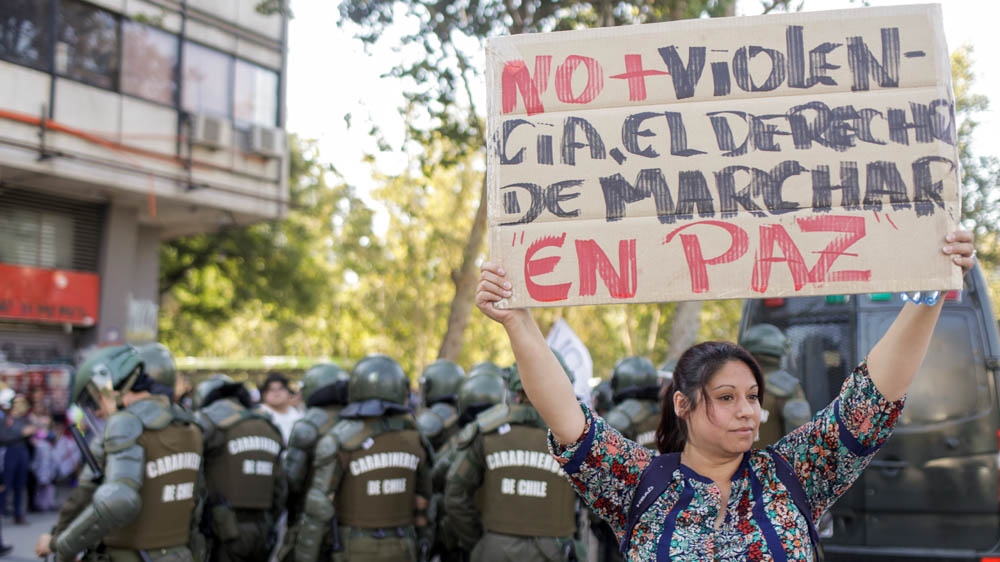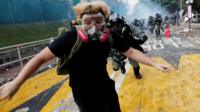Government concessions have failed to satisfy protesters who've vowed to stay in the streets until their demands are met
by Sandra Cuffe
18 Dec 2019

A woman waving a Chilean flag during a protest against
Chile's government in Santiago, Chile
[File: Andres Martinez Casares/Reuters]
MORE ON LATIN AMERICA
Despite unrest, Chile courts billions in foreign investmentyesterday
Bolivia's spat with Spain, Mexico deepens over Morales's alliesyesterday
How 2019 events shaped the world of business and economicsyesterday
Venezuela crisis: The refugees who fled a collapsed economyyesterday
Antofagasta, Chile - Wednesday marked two months since anti-government protests against structural inequality began in Chile.
Government officials are advancing a variety of measures in response to the demands of demonstrators, but protests are expected to continue as are crackdowns and alleged abuses by security forces.
More:
Chile constitution: Majority want to scrap Constitution
Chile police committed serious human rights abuses: UN report
Bid to impeach Chile's Pinera over protest handling rejected
As the government attempts to quell the protests, here are five things to know:
1. Why are people still protesting?
Secondary student protests on October 18 in the capital, Santiago, and the ensuing militarisation sparked broader nationwide mass protests against the country's political and economic model.
Marches, rallies and diverse actions continue on a daily basis.
"I think it is going to be difficult, but we are ready to continue to the very end," said Alberto Mamquepan, an Indigenous Mapuche dockworker in Antofagasta, 1,400km (860 miles) north of Santiago.
"We can achieve something here," he told Al Jazeera.

Protests continue amid concerns that security forces
MORE ON LATIN AMERICA
Despite unrest, Chile courts billions in foreign investmentyesterday
Bolivia's spat with Spain, Mexico deepens over Morales's alliesyesterday
How 2019 events shaped the world of business and economicsyesterday
Venezuela crisis: The refugees who fled a collapsed economyyesterday
Antofagasta, Chile - Wednesday marked two months since anti-government protests against structural inequality began in Chile.
Government officials are advancing a variety of measures in response to the demands of demonstrators, but protests are expected to continue as are crackdowns and alleged abuses by security forces.
More:
Chile constitution: Majority want to scrap Constitution
Chile police committed serious human rights abuses: UN report
Bid to impeach Chile's Pinera over protest handling rejected
As the government attempts to quell the protests, here are five things to know:
1. Why are people still protesting?
Secondary student protests on October 18 in the capital, Santiago, and the ensuing militarisation sparked broader nationwide mass protests against the country's political and economic model.
Marches, rallies and diverse actions continue on a daily basis.
"I think it is going to be difficult, but we are ready to continue to the very end," said Alberto Mamquepan, an Indigenous Mapuche dockworker in Antofagasta, 1,400km (860 miles) north of Santiago.
"We can achieve something here," he told Al Jazeera.

Protests continue amid concerns that security forces
have committed human rights abuses [Ricardo Moraes/Reuters]
Chile earned an international reputation for stability and prosperity following its return to democracy after General Augusto Pinochet's 1970-1990 dictatorship, but the country's economic growth has obscured high levels of income inequality and discontent.
Roughly two-thirds of Chileans think protests should continue, according to recent polls. An overhaul of the pension, health and education systems remain top priorities.
From day one, many protesters have also been calling for President Sebastian Pinera's resignation.
2. How has the government responded?
Over the course of the past two months, Pinera, a conservative billionaire, has presented a myriad of policies and proposals to address the situation, ranging from militarisation to poverty alleviation.
"They are like little aspirins," Martin, a metallurgist who requested only his first name be used, said of the measures announced by Pinera.
READ MORE
Chile protests: The students 'woke us up'
"Conditions are untenable," he told Al Jazeera. "We need to transform the whole model."
Pinera's announced pension increases and a subsidy that would top up the monthly minimum wage from $396 to $460 fall far short of union and social movement proposals for 500,000 pesos ($657) as both the monthly minimum wage and the minimum pension payment.
Chile's presidents of the House and Senate met the minister secretary-general of the presidency on Tuesday to request that Pinera withdraw his pension bill from consideration, arguing deeper structural reform is needed.
3. Who will write the new constitution?
Last month, ruling alliance and opposition politicians announced an agreement in response to widespread demand for the replacement of the dictatorship-era constitution, under which Chile operates, with a new one written by citizens.
A referendum will be held on April 26, 2020, to ask citizens if they want a new constitution and, if so, whether they would prefer a constitutional convention comprised of only elected citizens or a mixed citizen-legislator convention.
VIDEO
Chile consultation: Majority want to scrap constitution (2:30)
More than two million citizens voted last week in a non-binding consultation held in 225 of the country's 345 municipal districts. The preliminary results were clear: 92.4 percent of voters support a new constitution and 73.1 percent favour an all-citizen constitutional convention.
Legislators voted Wednesday on a bill that details the process, but rejected gender parity for a constitutional convention, as well as guaranteed representation for Indigenous peoples, amounting to roughly 12 percent of seats.
Eighty of 155 legislators voted in favour of gender parity and Indigenous representation, but the floor vote needed a 3/5 majority to pass and move on to the Senate. The results will likely generate significant fallout.
4. How are security forces responding?
Security forces have been repeatedly condemned for alleged human rights violations during crackdowns on protests. Pinera acknowledged abuses and has promised perpetrators will be investigated and punished.
Prosecutors are investigating 26 deaths in the context of the unrest, including deaths in police custody and killings by members of the military during a nine-day state of emergency in October, when the armed forces were deployed.
Legislators have been considering reforms proposed by Pinera that would redeploy the military to protect critical infrastructure. The government estimates arson, looting and property destruction have caused three billion dollars in damages.

A mural in Antofagasta uses police pellet projectiles
Chile earned an international reputation for stability and prosperity following its return to democracy after General Augusto Pinochet's 1970-1990 dictatorship, but the country's economic growth has obscured high levels of income inequality and discontent.
Roughly two-thirds of Chileans think protests should continue, according to recent polls. An overhaul of the pension, health and education systems remain top priorities.
From day one, many protesters have also been calling for President Sebastian Pinera's resignation.
2. How has the government responded?
Over the course of the past two months, Pinera, a conservative billionaire, has presented a myriad of policies and proposals to address the situation, ranging from militarisation to poverty alleviation.
"They are like little aspirins," Martin, a metallurgist who requested only his first name be used, said of the measures announced by Pinera.
READ MORE
Chile protests: The students 'woke us up'
"Conditions are untenable," he told Al Jazeera. "We need to transform the whole model."
Pinera's announced pension increases and a subsidy that would top up the monthly minimum wage from $396 to $460 fall far short of union and social movement proposals for 500,000 pesos ($657) as both the monthly minimum wage and the minimum pension payment.
Chile's presidents of the House and Senate met the minister secretary-general of the presidency on Tuesday to request that Pinera withdraw his pension bill from consideration, arguing deeper structural reform is needed.
3. Who will write the new constitution?
Last month, ruling alliance and opposition politicians announced an agreement in response to widespread demand for the replacement of the dictatorship-era constitution, under which Chile operates, with a new one written by citizens.
A referendum will be held on April 26, 2020, to ask citizens if they want a new constitution and, if so, whether they would prefer a constitutional convention comprised of only elected citizens or a mixed citizen-legislator convention.
VIDEO
Chile consultation: Majority want to scrap constitution (2:30)
More than two million citizens voted last week in a non-binding consultation held in 225 of the country's 345 municipal districts. The preliminary results were clear: 92.4 percent of voters support a new constitution and 73.1 percent favour an all-citizen constitutional convention.
Legislators voted Wednesday on a bill that details the process, but rejected gender parity for a constitutional convention, as well as guaranteed representation for Indigenous peoples, amounting to roughly 12 percent of seats.
Eighty of 155 legislators voted in favour of gender parity and Indigenous representation, but the floor vote needed a 3/5 majority to pass and move on to the Senate. The results will likely generate significant fallout.
4. How are security forces responding?
Security forces have been repeatedly condemned for alleged human rights violations during crackdowns on protests. Pinera acknowledged abuses and has promised perpetrators will be investigated and punished.
Prosecutors are investigating 26 deaths in the context of the unrest, including deaths in police custody and killings by members of the military during a nine-day state of emergency in October, when the armed forces were deployed.
Legislators have been considering reforms proposed by Pinera that would redeploy the military to protect critical infrastructure. The government estimates arson, looting and property destruction have caused three billion dollars in damages.

A mural in Antofagasta uses police pellet projectiles
responsible for eye injuries to spell the word 'dignity'
in braille [Sandra Cuffe/Al Jazeera]
To date, the National Human Rights Institute, an autonomous public institution, has filed nearly 700 legal actions against authorities, primarily the Carabineros police force, for torture, sexual violence and other crimes.
The institute has visited 3,461 injured patients, more than 10 percent of whom were hospitalised for eye injuries. The majority of those injuries were caused by police projectiles. At least two people have been completely blinded in both eyes.
To date, the National Human Rights Institute, an autonomous public institution, has filed nearly 700 legal actions against authorities, primarily the Carabineros police force, for torture, sexual violence and other crimes.
The institute has visited 3,461 injured patients, more than 10 percent of whom were hospitalised for eye injuries. The majority of those injuries were caused by police projectiles. At least two people have been completely blinded in both eyes.
OPINION
 What is behind state violence in Chile?
What is behind state violence in Chile?
by Michael Wilson-Becerril
&

by Rodrigo Espinoza-Troncoso
"Violence is very institutionalised," said Natali Flores, a coordinating member of Antofagasta's Emergency and Protection Committee, a grassroots initiative that organises medical, legal and other support efforts for local protests.
"It unleashed the fury of the population," she told Al Jazeera.
The office of the United Nations High Commissioner for Human Rights and international NGOs Amnesty International and Human Rights Watch have all recently released reports documenting and condemning alleged human rights violations.
5. Will protests hold in the new year?
Protests are expected well into the new year but will likely continue to somewhat subside over Christmas and the ensuing summer holidays in the southern hemisphere.
Many protesters, however, foresee a renewed surge in March, after the summer holidays end. Students at the helm of many protests will be back at school, or back occupying their schools, and campaigns will likely heat up in advance of the April referendum.
"We are in it with everything until it is over," muralist Raul Navarrete told Al Jazeera while dozens of Antofagasta residents worked on a nearby 200-foot-long mural he designed, depicting the protest movement.
"One way or another, we have to win," he said.










